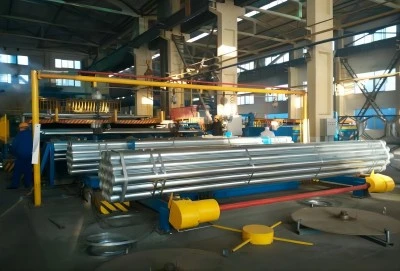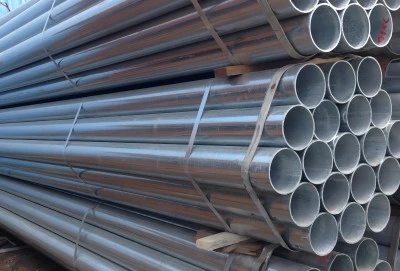The maximum pressure for ERW galvanized pipe varies depending on several factors, but typically ranges from 700 to 2,500 PSI (48 to 172 bar). ERW pipes are widely used in oil and gas transportation, water supply systems, and industrial applications due to their strength and corrosion resistance. The specific pressure rating depends on the pipe's diameter, wall thickness, material grade, and manufacturing process.
|
|
|
Factors Affecting ERW Pipe Pressure Ratings
Pipe diameter and wall thickness impact on pressure
The diameter and wall thickness of ERW galvanized pipes play a crucial role in determining their pressure ratings. As a general rule, pipes with smaller diameters and thicker walls can withstand higher pressures. For instance, a 2-inch ERW galvanized pipe with a Schedule 40 wall thickness might have a maximum working pressure of around 1,500 PSI, while a 12-inch pipe of the same schedule could be rated for only 800 PSI.
Wall thickness is particularly important, as it directly affects the pipe's ability to resist internal pressure. The relationship between pressure and wall thickness is governed by the hoop stress formula, which considers the pipe's diameter, allowable stress, and joint efficiency. Engineers and project managers must carefully consider these factors when selecting pipes for high-pressure applications.
Material grade and tensile strength considerations
The material grade of ERW galvanized pipes significantly influences their pressure-bearing capacity. Common grades include API 5L Grade B, X42, X52, and X60, with higher grades offering increased tensile strength and yield strength. For example, an X60 grade pipe can typically withstand higher pressures than a Grade B pipe of the same dimensions.
Tensile strength, which measures the pipe's resistance to longitudinal stress, is a key factor in determining pressure ratings. Higher tensile strength allows for thinner pipe walls while maintaining the same pressure rating, potentially reducing material costs and weight. However, it's essential to balance strength with other properties like ductility and weldability for optimal performance in various operating conditions.
Welding quality and joint integrity influence
The quality of the welding process in ERW pipes is critical to their pressure-bearing capacity. High-frequency welding, used in ERW pipe manufacturing, creates a strong, continuous seam. However, any defects in the weld can significantly reduce the pipe's ability to withstand pressure. Regular quality control measures, including non-destructive testing methods like ultrasonic inspection, are essential to ensure weld integrity.
Joint integrity is equally important, especially in pipeline systems where multiple pipe sections are connected. Proper welding techniques, appropriate fittings, and careful installation are necessary to maintain the overall system's pressure rating. Weak joints can become failure points under high pressure, potentially leading to leaks or catastrophic failures.
Industry Standards for ERW Pipe Pressure Limits
ASME B31.3 pressure ratings for ERW galvanized pipesThe American Society of Mechanical Engineers (ASME) B31.3 standard is widely used in the process piping industry, including for ERW galvanized pipes. This standard provides guidelines for determining allowable working pressures based on material properties, pipe dimensions, and operating temperatures. For ERW pipes, ASME B31.3 considers factors such as the pipe's yield strength, ultimate tensile strength, and design factor to calculate safe pressure limits.
ASME B31.3 also addresses the importance of temperature in pressure ratings. As temperatures increase, the strength of steel decreases, potentially lowering the maximum allowable working pressure. Engineers must account for these temperature effects when designing systems using ERW galvanized pipes, especially in high-temperature industrial applications.
API 5L specifications for oil and gas applications
The American Petroleum Institute's API 5L specification is crucial for ERW galvanized pipes used in oil and gas transportation. This standard defines requirements for seamless and welded steel line pipes, including ERW pipes. API 5L provides guidelines for material composition, mechanical properties, and testing procedures to ensure pipes can withstand the high pressures typical in oil and gas applications.
API 5L grades, such as X42, X52, and X60, correspond to increasing yield strengths, allowing for higher pressure ratings. The specification also addresses the importance of pipe ovality, wall thickness tolerances, and hydrostatic testing, all of which contribute to a pipe's ability to safely handle high pressures in demanding oil and gas environments.
ISO 3183 international standards for ERW pipe pressure
The International Organization for Standardization's ISO 3183 standard provides global guidelines for steel pipe used in pipeline transportation systems. This standard is particularly relevant for international projects involving ERW galvanized pipes. ISO 3183 covers various aspects of pipe manufacturing, including chemical composition, mechanical properties, and non-destructive testing requirements.
ISO 3183 aligns closely with API 5L, making it easier for global projects to maintain consistent quality and performance standards. The standard specifies different product specification levels (PSL1 and PSL2), with PSL2 having more stringent requirements suitable for high-pressure applications. This classification helps project managers and engineers select the appropriate pipe grade for specific pressure requirements in diverse geographic locations.
How to Determine the Right Pressure Rating?
Calculating maximum allowable operating pressure (MAOP)Determining the Maximum Allowable Operating Pressure (MAOP) for ERW galvanized pipes is a critical step in ensuring safe and efficient operations. The calculation involves considering the pipe's specified minimum yield strength (SMYS), nominal wall thickness, outside diameter, and a design factor. The basic formula for MAOP is:
MAOP = (2 * SMYS * t * F) / D
Where: - SMYS is the specified minimum yield strength - t is the nominal wall thickness - F is the design factor (typically 0.72 for most applications) - D is the outside diameter of the pipe
This calculation provides a theoretical maximum pressure, but practical considerations often require operating at lower pressures to account for safety margins and long-term durability.
Safety factors and design considerations for ERW pipes
Safety factors play a crucial role in determining the actual operating pressure of ERW galvanized pipes. These factors account for uncertainties in material properties, manufacturing variations, and potential environmental impacts. Typical safety factors range from 1.5 to 2.0, meaning the actual operating pressure is often set at 50-67% of the calculated MAOP.
Design considerations extend beyond pressure ratings to include factors such as: - Cyclic loading and fatigue resistance - Corrosion allowance - Temperature fluctuations - Soil conditions (for buried pipelines) - Seismic activity in the installation area
Engineers must carefully evaluate these factors to ensure the long-term integrity and safety of ERW galvanized pipe systems, especially in critical applications like oil and gas transportation or high-pressure water supply networks.
Pressure testing procedures for ERW galvanized pipes
Pressure testing is an essential step in verifying the integrity and pressure-bearing capacity of ERW galvanized pipes. Hydrostatic testing is the most common method, where pipes are filled with water and pressurized to a level above their intended operating pressure, typically 1.5 times the design pressure. This test helps identify any leaks, weak points, or manufacturing defects before the pipes are put into service.
The testing procedure typically involves: 1. Filling the pipe with water and removing air pockets 2. Gradually increasing pressure to the test level 3. Maintaining the test pressure for a specified duration (usually several hours) 4. Inspecting for leaks, deformation, or pressure drops 5. Gradually reducing pressure and draining the pipe
For large-scale projects or critical applications, additional non-destructive testing methods like ultrasonic inspection or radiographic testing may be employed to further ensure the quality and pressure resistance of ERW galvanized pipes.
Understanding the maximum pressure for ERW galvanized pipes is crucial for ensuring safe and efficient operations in various industries. While these pipes can typically handle pressures ranging from 700 to 2,500 PSI, the exact rating depends on multiple factors including diameter, wall thickness, material grade, and manufacturing quality. By adhering to industry standards like ASME B31.3, API 5L, and ISO 3183, and employing proper calculation methods and safety factors, engineers and project managers can confidently select and use ERW galvanized pipes in high-pressure applications. Regular testing and quality control measures further ensure the long-term reliability of these versatile piping solutions.
ERW Galvanized Pipe For Sale
Hebei Longma Group offers high-quality ERW pipes that meet the most stringent industry standards. Our state-of-the-art production facilities, equipped with German-imported machinery and four independently developed production lines, ensure consistent quality and precision. With over 300 skilled employees, including 60+ technical experts, we guarantee superior products backed by extensive knowledge and experience.
Our comprehensive testing facilities, featuring online ultrasonic automatic flaw detectors and industrial X-ray television, ensure every pipe meets the highest quality standards. We pride ourselves on fast delivery, with standard thickness pipes ready in as little as 7 days. Our pipes are certified by API 5L, ISO 9001, ISO 14001, and more, meeting global quality benchmarks.
Hebei Longma Group's ERW galvanized pipes are available in various specifications:
- Coating Type: Galvanized
- Outer Diameter: 60.3-1422mm
- Wall Thickness: 6.02-50.8mm
Experience our competitive pricing, made possible by our long-term partnerships with raw material suppliers and our integrated production model. To learn more about our ERW pipes or to place an order, contact us at info@longma-group.com.














